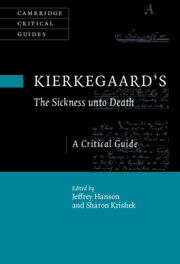43 results
12 - Conditions, Processes and Pressures Promoting Inclusive Organizations
-
-
- Book:
- Employer Engagement
- Published by:
- Bristol University Press
- Published online:
- 18 January 2024
- Print publication:
- 28 February 2023, pp 201-216
-
- Chapter
- Export citation
13 - Practice Case Study: Sephora’s Journey to an Inclusive Workplace and the ‘Let Us Belong’ Philosophy
-
-
- Book:
- Employer Engagement
- Published by:
- Bristol University Press
- Published online:
- 18 January 2024
- Print publication:
- 28 February 2023, pp 217-230
-
- Chapter
- Export citation
Broad Applications of Scanning Electron Microscopy and Energy-Dispersive Spectroscopy in Art Conservation
-
- Journal:
- Microscopy and Microanalysis / Volume 28 / Issue S1 / August 2022
- Published online by Cambridge University Press:
- 22 July 2022, pp. 2948-2949
- Print publication:
- August 2022
-
- Article
-
- You have access
- Export citation
Abbreviations
-
- Book:
- Kierkegaard's <I>The Sickness Unto Death</I>
- Published online:
- 26 August 2022
- Print publication:
- 21 July 2022, pp xi-xiv
-
- Chapter
- Export citation
Copyright page
-
- Book:
- Kierkegaard's <I>The Sickness Unto Death</I>
- Published online:
- 26 August 2022
- Print publication:
- 21 July 2022, pp vi-vi
-
- Chapter
- Export citation
Acknowledgments
-
- Book:
- Kierkegaard's <I>The Sickness Unto Death</I>
- Published online:
- 26 August 2022
- Print publication:
- 21 July 2022, pp x-x
-
- Chapter
- Export citation
Introduction
-
-
- Book:
- Kierkegaard's <I>The Sickness Unto Death</I>
- Published online:
- 26 August 2022
- Print publication:
- 21 July 2022, pp 1-5
-
- Chapter
- Export citation
Bibliography
-
- Book:
- Kierkegaard's <I>The Sickness Unto Death</I>
- Published online:
- 26 August 2022
- Print publication:
- 21 July 2022, pp 237-249
-
- Chapter
- Export citation
Index
-
- Book:
- Kierkegaard's <I>The Sickness Unto Death</I>
- Published online:
- 26 August 2022
- Print publication:
- 21 July 2022, pp 250-265
-
- Chapter
- Export citation
Chapter 11 - Despair the Disease and Faith the Therapeutic Cure
-
-
- Book:
- Kierkegaard's <I>The Sickness Unto Death</I>
- Published online:
- 26 August 2022
- Print publication:
- 21 July 2022, pp 182-199
-
- Chapter
- Export citation
Contributors
-
- Book:
- Kierkegaard's <I>The Sickness Unto Death</I>
- Published online:
- 26 August 2022
- Print publication:
- 21 July 2022, pp ix-ix
-
- Chapter
- Export citation

Kierkegaard's The Sickness Unto Death
- A Critical Guide
-
- Published online:
- 26 August 2022
- Print publication:
- 21 July 2022
Contents
-
- Book:
- Kierkegaard's <I>The Sickness Unto Death</I>
- Published online:
- 26 August 2022
- Print publication:
- 21 July 2022, pp vii-viii
-
- Chapter
- Export citation
Understanding the Global Patrimonial Wave – ERRATUM
-
- Journal:
- Perspectives on Politics / Volume 20 / Issue 3 / September 2022
- Published online by Cambridge University Press:
- 14 March 2022, p. 1161
- Print publication:
- September 2022
-
- Article
-
- You have access
- HTML
- Export citation
Understanding the Global Patrimonial Wave
-
- Journal:
- Perspectives on Politics / Volume 20 / Issue 1 / March 2022
- Published online by Cambridge University Press:
- 02 July 2021, pp. 237-249
- Print publication:
- March 2022
-
- Article
- Export citation
Simultaneously vanishing higher derived limits
- Part of
-
- Journal:
- Forum of Mathematics, Pi / Volume 9 / 2021
- Published online by Cambridge University Press:
- 14 June 2021, e4
-
- Article
-
- You have access
- Open access
- Export citation
Early identification of impending cardiac arrest in neonates and infants in the cardiovascular ICU: a statistical modelling approach using physiologic monitoring data – CORRIGENDUM
-
- Journal:
- Cardiology in the Young / Volume 29 / Issue 11 / November 2019
- Published online by Cambridge University Press:
- 09 October 2019, p. 1349
-
- Article
-
- You have access
- HTML
- Export citation
Early identification of impending cardiac arrest in neonates and infants in the cardiovascular ICU: a statistical modelling approach using physiologic monitoring data
-
- Journal:
- Cardiology in the Young / Volume 29 / Issue 11 / November 2019
- Published online by Cambridge University Press:
- 09 September 2019, pp. 1340-1348
-
- Article
- Export citation
Eighteen years of paediatric extracorporeal membrane oxygenation and ventricular assist devices: insight regarding late outcomes
-
- Journal:
- Cardiology in the Young / Volume 28 / Issue 11 / November 2018
- Published online by Cambridge University Press:
- 17 September 2018, pp. 1316-1322
-
- Article
- Export citation
Managing Herbicide Resistance: Listening to the Perspectives of Practitioners. Procedures for Conducting Listening Sessions and an Evaluation of the Process
-
- Journal:
- Weed Technology / Volume 32 / Issue 4 / August 2018
- Published online by Cambridge University Press:
- 09 August 2018, pp. 489-497
-
- Article
-
- You have access
- Open access
- HTML
- Export citation
















